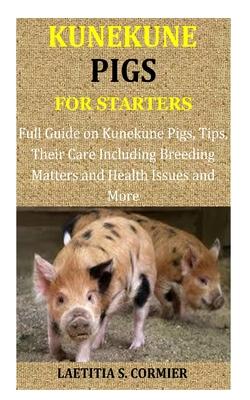
Book
Kunekune Pigs for Starters: Full Guide on Kunekune Pigs, Tips, Their Care Including Breeding Matters and Health Issues and More
(Write a Review)
Paperback
$10.46
Full Guide on Kunekune Pigs, Tips, Their Care Including Breeding Matters and Health Issues and More The domesticated pigs (that is, Sus scrofa domesticus) kunekune is tiny and shaggy. Kunekunes have a strong connection to the Māori, an indigenous population from island New Zealand. The Māori word kunekune translates to "fat and round". Kunekune pigs graze, unlike most domestic pigs. They thrive on grass alone.
Kunekune pigs are gregarious and run to meet their caregivers in the morning. Body Description-Kunekune pigs are little domestic pigs. These pigs have silky, coarse, or curly hair and come in cream, black, ginger, brown, as well as white. They have solid or speckled coats. Their hair also gets warmer or just thicker with the seasons and sheds in warmer months. Many kunekune hogs have fleshy "piri piri" wattles on their faces. They have semi-lopped ears and curled tails. Natural Habitat-Pigs, domestic counterparts of wild boars, may flourish in many settings. The kunekune breed's origin is uncertain, however it resembles domestic pigs from Asia, South America, as well as the Polynesian Islands. Modern kunekune pigs may have originated from whalers who brought them to New Zealand during the 19th century and traded among the Māori people.
Communication Kunekune pigs communicate by vocalization, body language, and scent markers. A happy, low-pitched grunt usually indicates pig relaxation. They additionally emit this noise when meeting. Pigs show tension or anxiety with high-pitched calls. These pigs express their feelings by waving their tails and ears.
And kunekune pigs typically live 15-20 years. This great book will teach you everything you need to know about kunekune pig care and much more.
Full Guide on Kunekune Pigs, Tips, Their Care Including Breeding Matters and Health Issues and More The domesticated pigs (that is, Sus scrofa domesticus) kunekune is tiny and shaggy. Kunekunes have a strong connection to the Māori, an indigenous population from island New Zealand. The Māori word kunekune translates to "fat and round". Kunekune pigs graze, unlike most domestic pigs. They thrive on grass alone.
Kunekune pigs are gregarious and run to meet their caregivers in the morning. Body Description-Kunekune pigs are little domestic pigs. These pigs have silky, coarse, or curly hair and come in cream, black, ginger, brown, as well as white. They have solid or speckled coats. Their hair also gets warmer or just thicker with the seasons and sheds in warmer months. Many kunekune hogs have fleshy "piri piri" wattles on their faces. They have semi-lopped ears and curled tails. Natural Habitat-Pigs, domestic counterparts of wild boars, may flourish in many settings. The kunekune breed's origin is uncertain, however it resembles domestic pigs from Asia, South America, as well as the Polynesian Islands. Modern kunekune pigs may have originated from whalers who brought them to New Zealand during the 19th century and traded among the Māori people.
Communication Kunekune pigs communicate by vocalization, body language, and scent markers. A happy, low-pitched grunt usually indicates pig relaxation. They additionally emit this noise when meeting. Pigs show tension or anxiety with high-pitched calls. These pigs express their feelings by waving their tails and ears.
And kunekune pigs typically live 15-20 years. This great book will teach you everything you need to know about kunekune pig care and much more.
Paperback
$10.46